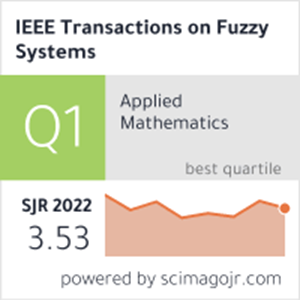Misclassification-Error-Inspired Ensemble of Interpretable First-Order TSK Fuzzy Subclassifiers: A Novel Multiview Learning Perspective
IF 10.7
1区 计算机科学
Q1 COMPUTER SCIENCE, ARTIFICIAL INTELLIGENCE
引用次数: 0
Abstract
This study explores a novel interpretable Takagi–Sugeno–Kang (TSK) fuzzy ensemble classifier called MEI-TSK from a multiview learning perspective. Unlike most existing fuzzy ensemble classifiers where aggregation learning performs only after the training of multiple fuzzy subclassifiers, MEI-TSK first allows the determination of the antecedents of all fuzzy rules in an individual way for each of TSK fuzzy subclassifiers. It then employs the proposed misclassification-error-inspired learning to accomplish its ensemble learning by training the consequents of all fuzzy rules of each TSK fuzzy subclassifier in a multiview learning way with the simplest averaging aggregation. As a result, the misclassification error caused by such an ensemble learning of fuzzy subclassifiers is theoretically upper bounded. MEI-TSK also features the use of both Bernoulli random feature selection and random feature permutation. The permuted features can be conveniently useful for determining all the antecedents of fuzzy rules with diversity guarantee among all the subclassifiers, and accordingly, be discarded after ensemble learning, resulting in shorter fuzzy rules and improved generalization capability. The experimental results indicate the effectiveness of MEI-TSK in terms of classification performance and/or interpretability.可解释一阶TSK模糊子分类器的误分类-错误启发集成:一种新的多视角学习视角
本研究从多视角学习的角度探讨了一种新的可解释的Takagi-Sugeno-Kang (TSK)模糊集成分类器MEI-TSK。与大多数现有的模糊集成分类器不同,聚合学习只在训练多个模糊子分类器后才进行,MEI-TSK首先允许为每个TSK模糊子分类器以单独的方式确定所有模糊规则的前项。然后,采用提出的误分类-错误启发学习方法,以最简单的平均聚合的多视图学习方式训练每个TSK模糊子分类器的所有模糊规则的结果,完成集成学习。因此,这种模糊子分类器的集成学习导致的误分类误差在理论上是有上限的。MEI-TSK还使用了伯努利随机特征选择和随机特征排列。排列后的特征可以方便地确定所有子分类器之间具有多样性保证的模糊规则的所有前项,并在集成学习后被丢弃,从而使模糊规则更短,提高了泛化能力。实验结果表明,MEI-TSK在分类性能和可解释性方面是有效的。
本文章由计算机程序翻译,如有差异,请以英文原文为准。
求助全文
约1分钟内获得全文
求助全文
来源期刊

IEEE Transactions on Fuzzy Systems
工程技术-工程:电子与电气
CiteScore
20.50
自引率
13.40%
发文量
517
审稿时长
3.0 months
期刊介绍:
The IEEE Transactions on Fuzzy Systems is a scholarly journal that focuses on the theory, design, and application of fuzzy systems. It aims to publish high-quality technical papers that contribute significant technical knowledge and exploratory developments in the field of fuzzy systems. The journal particularly emphasizes engineering systems and scientific applications. In addition to research articles, the Transactions also includes a letters section featuring current information, comments, and rebuttals related to published papers.
 求助内容:
求助内容: 应助结果提醒方式:
应助结果提醒方式:


